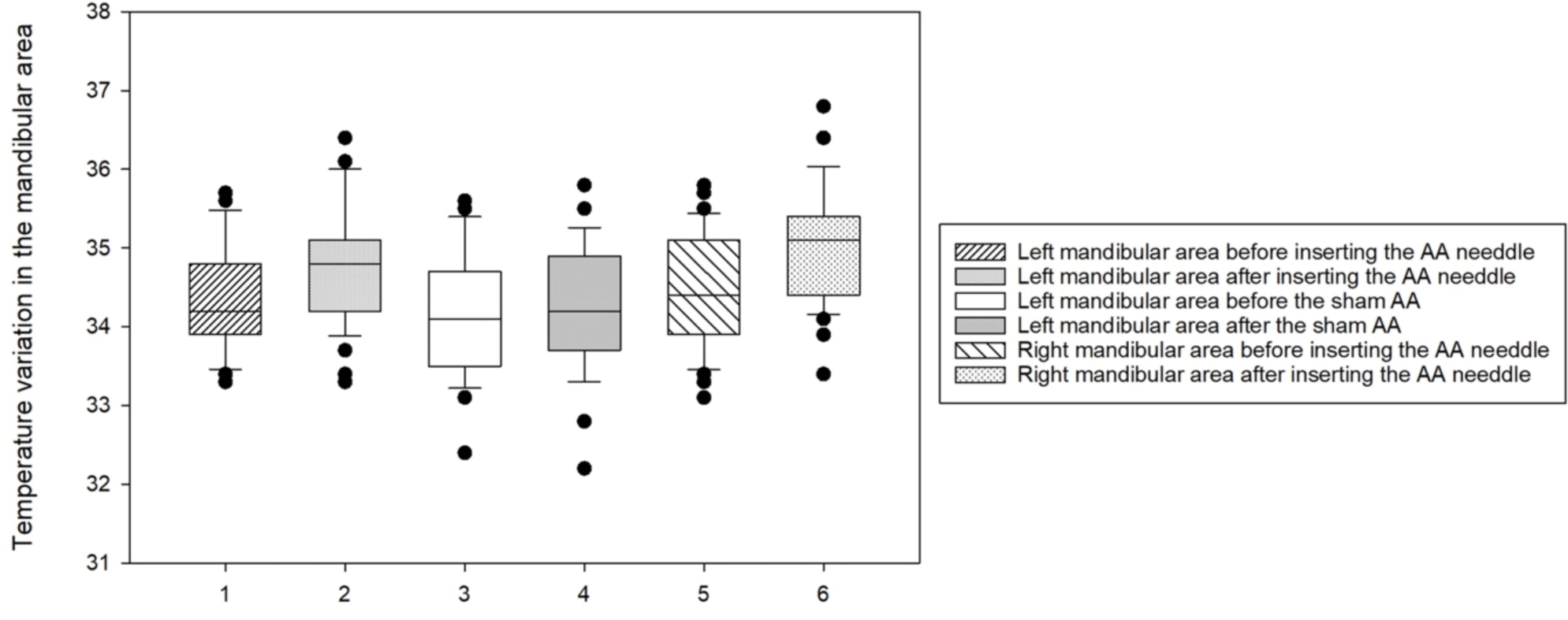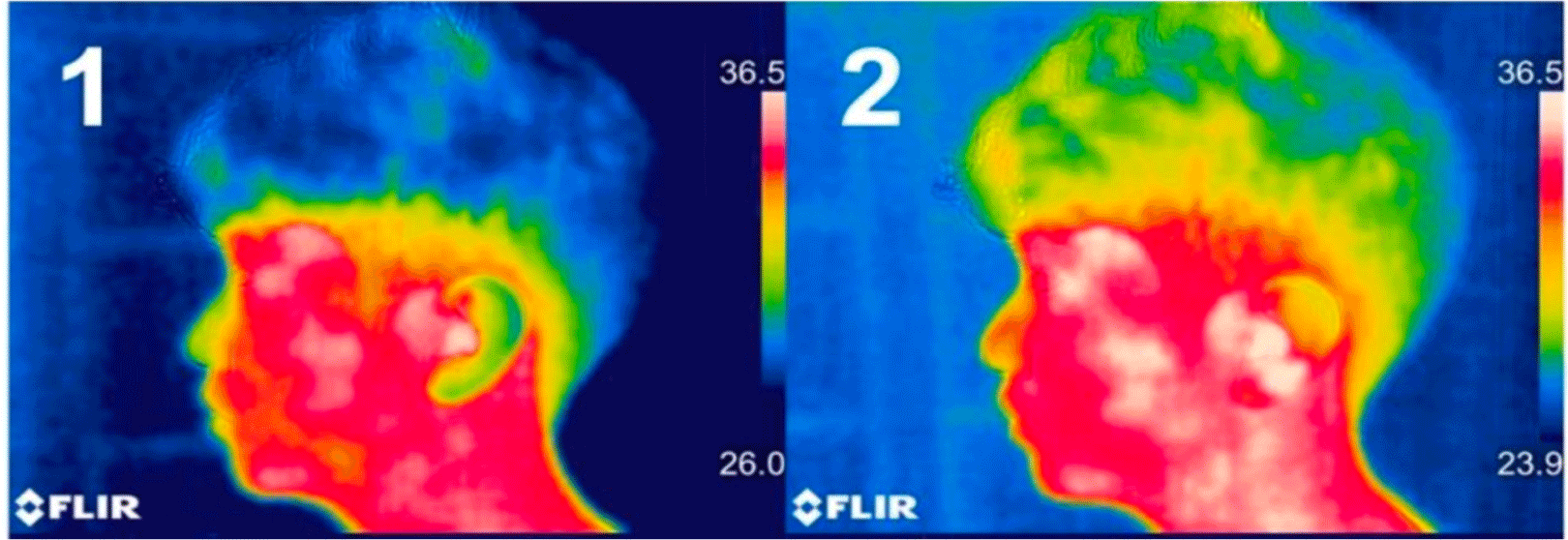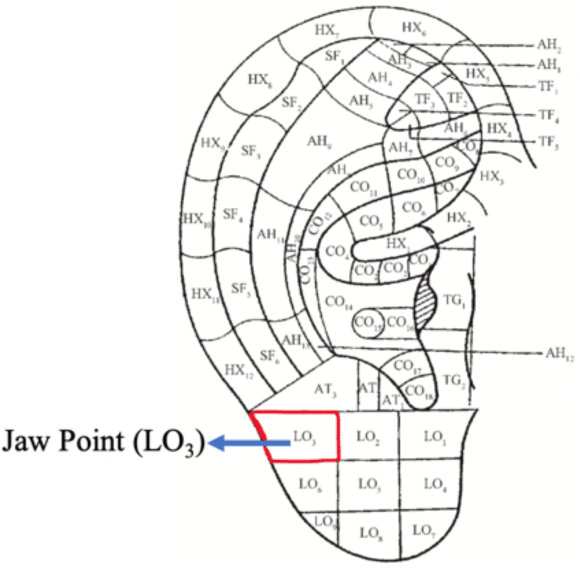1. INTRODUCTION
Auricular acupuncture (AA) is a type of acupuncture in which the impact point is the location and the representative regions in the pinna are linked to diseases in the organs of the body [1,2]. In particular, AA has been shown to increase the threshold for dental pain, reduce pain level according to the VAS (Visual analogue scales) in the first 24 hours, reduce pain medication use in the 72 hours after wisdom tooth extraction surgery, and reduce pain caused by temporomandibular disorders [3,4,5]. However, the actual mechanism of AA is still not fully understood. Several theories, including the homoncular theory and the meridianism theory, have been proposed [2]. Several studies demonstrate that acupoints on the pinna have a corresponding relationship to areas of the body based on electrical resistance at acupoints on the pinna [6]. To investigate the relationship between acupoints on the pinna and the corresponding body regions, we initially chose acupoints with corresponding regions on the same nerve section for the study. Jaw acupoints are widely used to treat pain in dentistry [1,3,4]. This point is located in the lobule of the auricle which the great auricular nerve from the C2 and C3 roots governs sensation. So, is the Jaw point on the ear related to the mandibular area? Based on the research of Vu TL, who studied the change in skin surface temperature to determine the relationship between the Lieque (LU-7), Weizhong (BL-40) acupoints and the neck, dorsal region [7,8], we used a thermographic camera to survey if the skin temperature changed in the mandibular area before and after inserting the needle at the Jaw point on the ear to test the above hypothesis.
2. MATERIALS AND METHOD
This study was conducted in the Acupuncture Experimental Research Lab, Faculty of Traditional Medicine, University of Medicine and Pharmacy at Ho Chi Minh City from November 2021 to May 2022.
Study design: A cross-over study
Participants criteria included: Healthy males and females between the ages of 18 and 30 who have no history of hyperthyroidism and hypothyroidism were required to meet the inclusion criteria. They also needed to have vital signs that fell within the normal range (resting heart rate: 60-100 beats/min; resting blood pressure: from 90/60 mmHg to less than 140/90 mmHg; breathing rate: 16 ± 3 times/min; temperature: 36.6-37.5°C, SpO2 ≥ 95%) and their BMIs ranged from 18.5 to 23 kg/m2. On the day of the AA, none of the participants reported a psychological stress issue (confirmed by answering the DASS21 questionnaire with stress point less than 15 points).
Participant’s elimination criteria: Exclusion criteria included individuals who had used stimulants such as beer, wine, caffeine, or cigarettes within the 24 hours prior to the study. Volunteers participated in athletics two hours before the research or had skin injuries in the AA region or survey area. The subjects used acupuncture, massage, cupping in the ears and jaw areas before 1 day or were suffering from the maxillofacial diseases. Women who were menstruating, pregnant, or breastfeeding, people who used vasodilators, and people who applied suntan lotion to their faces were also barred.
Criteria to stop research: Participants who desired to withdraw from the research or who overreacted to parasympathetic stimulation symptoms such as dizziness, nausea, vomiting, and allergy at the stimulus site met the criterion. These incidents would be reported as adverse events.
The sample size n is calculated according to the formula:
Formula note: With α=0.05, β=0.2, μDiff=0.65 and σDiff=0.93, we can calculate n = 35 [7,8].
A Flir C5 thermographic camera made in Estonia measures the skin temperature of the survey area. Auricular acupuncture: We were using press-tack needles (a sticker with needle dimensions of 0.22 x 1.3 mm) that were sterilized for experimental stages and a sticker without needle (sham AA) for control stages.
Jaw point (LO3): This point is in the 3rd part when dividing the earlobe into 9 parts. Temperature investigation area: mandibular area on both sides.
Participants were recruited and the processes were explained. Volunteers would sign an informed consent form before the study. Volunteers were familiarized with the environment for 10 minutes to stabilize their breathing rate, blood pressure, and heart rate and to stop sweating.
Stage 1: Five minutes before the needle was inserted, study participants were measured for the first time for breathing rate, blood pressure, heart rate, and temperature. Then, disinfect the lobule of the auricle to be inserted with an alcohol pad, and then proceed to insert the left Jaw point. For 5 minutes, the researcher presses and rubs the auricular point with her thumb and index finger. Withdraw needle. Right after that, we check skin temperature, pulse, breathing rate and blood pressure.
Stage 2: The volunteers rested for 30 minutes for the skin temperature to return to normal.
Phase 3: Study participants were measured for their breathing rate, blood pressure, heart rate, and temperature before the needle was inserted for 5 minutes. Then, disinfect the lobule of the auricle to be inserted with an alcohol pad, and then proceed to insert the right Jaw point. For 5 minutes, the researcher presses and rubs the auricular point with her thumb and index finger. Withdraw needle. Right after that, we check skin temperature, pulse, breathing rate and blood pressure.
Stage 4: The volunteers rested for 30 minutes for the skin temperature to return to normal.
Stage 5: Study participants were measured for their breathing rate, blood pressure, heart rate, and temperature before sham acupuncture. Then, disinfect the lobule of the auricle to be inserted with an alcohol pad, and then proceed to stick the needleless patch on the left lobule of the auricle. For 5 minutes, the researcher presses and rubs the auricular point with her thumb and index finger. Remove the sticker. Right after that, we check skin temperature, pulse, breathing rate and blood pressure. Complete the study.
Full trial protocol can be accessed on website https://clinicaltrials.gov with registration number: NCT05164302 and name of trial registry “Skin Surface’s Temperature Change When Auricular Acupuncture at Jaw Point and Tooth Point”.
The skin temperature in the mandibular region before and after inserting needles was the primary outcome, quantitative variable, measured from a Flir C5 thermographic camera.
Adverse events: Evaluate the adverse events during the study period including: nausea, vomiting, allergy at the stimulus area, dizziness, hypotension, faint.
Analyzing statistics using Stata 14.0.
Qualitative variables: age, gender, BMI are described with mean and standard deviation, adverse events are described with percentage.
Quantitative variables: The skin temperature in the mandibular region before and after inserting needles are described with mean and standard deviation, using Paired T-test for comparison. The results were statistically significant when p < 0.05.
3. RESULTS
| Characteristics | Mean ± SD | Min | Max |
|---|---|---|---|
| Age | 20.63 ± 1.00 | 18 | 23 |
| Male | 14 (40%) | ||
| Female | 21 (60%) | ||
| BMI | 20.85 ± 1.47 | 18.0 | 22.9 |
There are 35 participants in the study, ranging in age from 18 to 23; the average age was 20, with 40% of men and 60% of women. Their BMI ranged from 18.0 to 22.9 kg/m2, with the average being 20.85 kg/m2.
| Left mandibular area | Right mandibular area | p | |
|---|---|---|---|
| Before | 34.34 ± 0.69 | 34.34 ± 0.72 | 0.9316* |
| After | 34.76 ± 0.72 | 34.40 ± 0.86 | 0.0000* |
| p† | 0.0000* | 0.4955* |
After inserting the needle in the left Jaw acupoint, the temperature of the left mandibular area is increased statistically from before the needle insertion (p < 0.05), but the temperature of the right mandible is not statistically significant compared to before needle insertion (p > 0.05). Before inserting the needle into the left Jaw acupoint, the temperature of the left and right mandibular areas was not statistically significant (p > 0.05). After inserting the needle in the left Jaw point, the temperature of the left and right mandibular areas was significantly different (p < 0.05).
After inserting the needle in the right Jaw acupoint, the temperature of the right mandibular area is increased statistically from before the needle insertion (p < 0.05), but the temperature of the left mandible is not statistically significant compared to before needle insertion (p > 0.05). Before inserting the needle into the right Jaw acupoint, the temperature of the left and right mandibular areas was not statistically significant (p > 0.05). After inserting the needle in the right Jaw point, the temperature of the left and right mandibular areas was significantly different (p < 0.05).
| Left mandibular area | Right mandibular area | p | |
|---|---|---|---|
| Before | 34.50 ± 0.86 | 34.49 ± 0.73 | 0.9015* |
| After | 34.31 ± 0.68 | 34.99 ± 0.71 | 0.0000* |
| p † | 0.0709* | 0.0000* |
| Left mandibular area | Right mandibular area | p | |
|---|---|---|---|
| Before | 34.16 ± 0.80 | 34.31 ± 0.63 | 0.1782* |
| After | 34.20 ± 0.80 | 34.31 ± 0.74 | 0.0927* |
| p † | 0.0705* | 0.9542* |
After sticking the needleless patch in the left Jaw acupoint, the temperature of the left mandibular area is not significantly different from before the needle insertion (p >0.05), the temperature of the right mandible is not statistically significant compared to before the needle insertion (p>0.05). Before inserting the needle into the left Jaw acupoint, the temperature of the left and right mandibular areas was not statistically significant (p > 0.05). After inserting the needle in the left Jaw point, the temperature of the left and right mandibular areas was not significantly different (p > 0.05).


| No. | Adverse events | Prop (%) N=35 |
|---|---|---|
| 1 | Nausea, vomiting | 0 |
| 2 | Allergy at the stimulus area | 0 |
| 3 | Dizziness | 0 |
| 4 | Hypotension | 0 |
| 5 | Faint | 0 |
No side effects were observed when needles were inserted into the Jaw point during the study.
4. DISCUSSION
The study was conducted on 35 healthy volunteers (14 men, 21 women). According to a study by Lu SH and Dai YT in 2009 on body temperature, gender factors affect body temperature when recorded by infrared camera [9]. However, this difference depends on three factors: the menstrual cycle, the subcutaneous fat layer, and the metabolic rate [10]. The BMI of the study participants was within the normal range in our study, 20.85 ± 1.47, and we excluded those who were in the menstrual cycle and those with metabolic diseases. Age is recognized as one of the factors that affect body temperature [9]. However, in the age group from 18 to 28, the skin temperature did not differ. In our study, the mean age was 20.63 ± 1.00. In addition, skin temperature is also affected by psychological factors; stress can cause hyperthermia or hypothermia [11,12]. To overcome this problem, we checked study participants with the Depression, Anxiety and Stress Scale - 21 (DASS 21) before conducting the study and selected subjects whose scores were within the normal range. Therefore, the characteristics of the study population were homogeneous, excluding the bias of skin temperature.
The study by Oliver Schlager et al. (2011) hypothesized that electrical auricular acupuncture could reduce symptoms in primary Raynaud’s syndrome. The study recruited 26 primary Raynaud patients, and they were treated with AA at the points of Shenmen, Fingers, and Hands with a frequency of 1 Hz. Skin temperature was assessed by infrared thermography and Laser Doppler imaging to determine the degree of skin perfusion. Skin temperature and skin perfusion did not change significantly during the study period (skin temperature at the third week: 31.2 ± 3.7 vs. 31.8 ± 4.2 °C, at the sixth week: 31.2 ± 3.7 vs. 32.4 ± 3.6 °C, and after 24th weeks: 31.2 ± 3.7 vs. 32.8 ± 3.8 °C, skin temperature increased but not statistically significantly after electrical auricular acupuncture) [13]. The results are different when compared with our study. After inserting a needle for AA on the left Jaw point, the temperature of the left mandibular area was significantly different from before inserting the needle, going from 34.34 ± 0.69 to 34.76 ± 0.72 (p<0.05). After inserting a needle for AA on the right Jaw point, the temperature of the right mandibular area was statistically different from before insertion of needle, going from 34.49 ± 0.73 to 34.99 ± 0.71 (p<0.05). After sham AA at the jaw points, the skin temperature of the lower jaw area was not statistically significant (p>0.05). To explain this difference, we believe that the study subjects in two different study groups - ours on healthy people and Oliver Schlager’s on patients with primary Raynaud’s syndrome. It is possible that in patients with primary Raynauld there is impaired skin thermoregulation compared with healthy subjects, and in addition to nitric oxide and endothelium-dependent factors, there may be endothelium-independent mechanisms contributing to significant contribution to cold vasospasm in patients with primary Raynaud’s syndrome.
We compared the results to those of studies on temperature change during body acupuncture because the number of studies on temperature change during AA was limited. When compared to the findings of author Vu TL, who investigated the change in skin surface temperature to determine the relationship between the Lieque (LU-7), Weizhong (BL-40) acupoints and the neck, dorsal region, Vu TL found that the skin temperature is related to the acupoint location change before and after body acupuncture and is statistically significant (p<0.05), namely the increase in temperature [7,8]. Our study also showed that after inserting the Jaw acupuncture needle, the temperature of the mandibular areas also increased statistically significantly. However, our results have some differences; the temperature of the mandibular area on the side of using auricular acupuncture increased statistically. In contrast, in Vu Thanh Liem’s study, when body acupuncture was performed on the left or right side, the temperature of the neck and dorsal areas on both sides increased significantly (p<0.05). In addition, in our study, we had more advantages when adding sham AA to compare and record the difference in skin temperature in the mandibular area was not statistically significant (p>0.05). When compared to Guan L’s study, which discovered the relationship between the face area and the Hegu point (LI-4) by surveying the change in facial skin temperature during moxibustion at the LI-4 point, our findings are similar. Guan L showed that the temperature of the face increased after moxibustion at the LI-4 point after 15 minutes in healthy volunteers, especially the temperature around the lips (p<0.05) [14].
AA side effects are infrequent, mild, temporary, and manageable [15]. Pain, dizziness, nausea, and bleeding at the site of needle removal were the most commonly reported side effects. There may also be additional consequences, such as ear infections or perichondritis [1,15]. Unwanted consequences, such as infection and cartilage inflammation, can be avoided by thoroughly cleaning the skin of the ears before inserting the needle. We followed the aforementioned guidelines throughout the trial and kept track of no negative effects. In addition, AA has also been shown to be safe for cancer and dementia patients [16,17]. The findings of our study support the notion that auricular acupuncture is a safe kind of treatment since they are in line with the majority of other research findings.
This is the first study to survey the change in temperature of the skin surface when using AA at the jaw point on each side of the ear in healthy people. Study subjects were evaluated on the DASS-21 scale before participating in order to avoid psychological factors affecting skin temperature. In addition, our study is newer than previous studies because it investigates changes in skin temperature even during sham acupuncture. Therefore, the results of the study eliminate the psychological factors that confound the temperature change, increasing the authenticity of the research. The findings of the study bring evidence-based medicine to AA in particular and to acupuncture in general. Furthermore, it adds an applied scientific basis for teaching as well as a foundation for AA research, particularly when studying the use of Jaw acupoints. The sample size of the study is limited, and there are not many studies on AA related to temperature surveys, most of the compared studies are studies on body acupuncture, without many similarities. As a result, we recommend conducting more similar studies with a larger number of sample sizes on the patient to investigate the change in skin surface temperature at other common acupoints on the ears.


